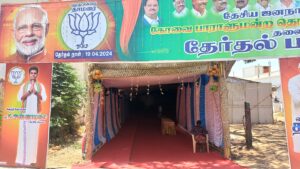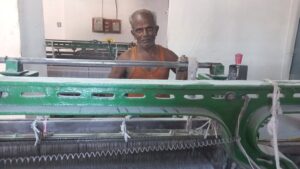Influence of caste groups, stronghold of trade unions, robust MSMEs, history of communal riots make Coimbatore a seat to watch out for in Tamil Nadu.

Coimbatore Ground Report
The Coimbatore district was never crucial to the electoral prospects of the Dravidian political majors, the DMK and AIADMK, in Tamil Nadu.
The industrial importance of the Coimbatore region has never resonated politically, and it is set to change in the 2024 Lok Sabha electoral battle, with the BJP fighting alone in a three-cornered contest.
South First travelled across the constituency to understand whether the media hype about the highly intensive fight matched the ground reality.
Before getting into the actual story, here are some basic details: According to the Election Commission of India data, the Coimbatore Parliament constituency has 21,06,124 voters, comprising 10,64,394 females, 10,41,349 males, and 381 transgenders.
Coimbatore South, Coimbatore North, Kavundampalayam, Singanallur, and Sulur Assembly constituencies in the Coimbatore district and the Palladam segment in Tirupur fall under the Coimbatore Lok Sabha constituency. While the first four are completely urban constituencies, Sulur and Palladam are semi-urban, semi-rural segments.
One-sixth of Tirupur city corporation that falls under the Palladam Assembly segment is also a part of the Coimbatore Lok Sabha constituency.
The constituency has grabbed much hype and attention, thanks to the candidature of BJP state president K Annamalai’s presence. He is contesting against DMK’s Ganapathi P Raj Kumar, who defected from AIADMK, and Singai G Ramachandran of the AIADMK.
On 25 September last, AIADMK parted ways with the BJP. Though it will split the anti-DMK votes in the constituency, it will not take the heat out of the contest.
The BJP has its vote bank in Coimbatore, unlike in many other parts of the state where it needs an alliance. The well-oiled BJP machinery and the separate voter base have effectively prepared the ground for a triangular contest.

A deserted BJP election office at Palladam. The only occupant was there to escape the summer sun. (South First)
The flourishing textile trade during the British era, and the growth of the engineering and manufacturing industry that followed made Coimbatore not just an industrial city but also a fertile ground for trade unions.
Even after the political scenario of the state changed in 1967 when the DMK dethroned the Congress from power and started the era of Dravidian politics in the state, the Congress and the Left parties (CPI and CPI-M) continued to have a strong grip over Coimbatore.
In the previous 19 elections (including two bypolls), the Dravidian majors won the seat only three times —the DMK in 1980 and 1996, and the AIADMK in 2014, the only time the latter contested from Coimbatore.
The constituency elected either the Left or Congress candidates during the remaining elections.
The AIADMK was forced to contest from Coimbatore in 2014 as party supremo J Jayalalithaa decided to go alone in the polls, ditching any alliance. The party then won 37 out of the 39 seats in Tamil Nadu, and Coimbatore was the seat it won by the lowest margin of 42,016 votes.
While the BJP was the runner-up, the DMK finished a distant third with just 18.73 percent votes.
Until the 1991 general elections, both DMK and AIADMK mostly allocated the Coimbatore seat to their allies, the Congress or the Left, owing to their strong trade union base that effectively translated into votes.
Coimbatore’s political landscape changed after the 1997 communal riots, triggered by the murder of a police constable allegedly by the members of Al-Ummah, a Tamil Nadu-based extremist organisation. According to the then media reports, at least 18 Muslims and two Hindus were killed in the riots.
A series of bomb blasts ripped through the city on 14 February 1998, the day on which BJP leader LK Advani was to address an election rally. The terror act took 58 lives.
The Tamil Nadu government banned Al-Ummah following the blasts. Another organisation, the Jihadi Committee, too, was banned.
The BJP candidate, CP Radhakrishnan (now the Governor of Jharkhand), won the election by securing more than 55 percent of votes in alliance with the AIADMK. When the alliance equations changed and the country went to polls the next year, DMK gave the seat to BJP. Radhakrishnan won again with nearly 50 percent of the votes.
It was the last time that Coimbatore had a BJP MP.
Though the BJP lost all the four elections it contested since 2004, it polled over 30 percent in three of them. The party got less than five percent votes in 2009 when it contested alone.
However, the party polled more than 31 percent votes in 2014 without being in alliance with either of the two Dravidian majors. The 2014 result has made the party — and Annamalai — hopeful of a win this time.
The Kongu Vellala Gounders, a socially and economically powerful Other Backward Caste community, form the numerical majority in the western districts of Tamil Nadu, known as the Kongu region. The DMK was relatively weak in the region.
In the 2016 Assembly elections, the DMK performed better than or matched the AIADMK across the state, except in Kongu. But the incumbent AIADMK’s clean sweep in the western districts returned it to power.
The Kongu region mostly elected AIADMK candidates in the 2021 Assembly polls as well. The AIADMK-BJP combine won 10 seats in Coimbatore, with the Dravidian party claiming nine segments.
After two back-to-back blows in Coimbatore, the DMK made Karur district secretary and former minister V Senthil Balaji the party’s in-charge in Coimbatore.
Though an outsider, Senthil Balaji won wider support in the party and the public, thanks to his Kongu Vellala Gounder caste background, despite initial murmurs of dissent by the local DMK functionaries.
In less than 10 months, the DMK alliance won 96 of the 100 wards in the city corporation and 31 out of the 33 town panchayats in the district.
Balaji’s first act after coming to Coimbatore was to rejig the grassroots-level party units across the district. Though it seemingly helped the party, there were some repercussions. The local-level functionaries who lost power and influence within the party switched their loyalties to the AIADMK or the BJP.
The defections, albeit indirectly, helped the BJP. The party made inroads into rural areas where it never had formal units.
For instance, the vice-president of Kannamapalayam town panchayat in the district, also a ward councilor, switched over to the BJP along with three other ward councilors. Now, the BJP has four ward councilors in a local body where the party lacked a strong presence two years ago.
Despite Senthil Balaji being in jail following his arrest by the Enforcement Directorate, the party structure that he built in the district remains intact. However, there is no charismatic and shrewd leader for the DMK in Coimbatore including its MP candidate.
The central agency arrested Balaji under the Prevention of Money Laundering Act on 14 June last year. The case, widely known as the cash-for-jobs scam, dates back to 2011-15, when he was the transport minister in the AIADMK government.
He resigned from the MK Stalin-led Cabinet eight months after his arrest.
Interestingly, Annamalai on Monday, 8 April, accused Senthil Balaji of guiding DMK workers over the phone from prison.
AIADMK which historically commanded huge support in Coimbatore and adjacent districts is not on the offensive as the BJP and DMK this time.
Its candidate, Singai G Ramachandran, a political dynast is also an IIM alumnus like Annamalai. However, his professional persona seems to be a hindrance to connecting with the grassroots. Casual workers, auto-rickshaw drivers, and the general public feel that the fight is between the BJP and the DMK.
An auto-driver from Avinashi Road, who does not wish to be named, told South First that AIADMK could have fielded a strong candidate.
“The party is strong in Coimbatore. But the BJP and DMK are hogging the limelight,” he said. Though DMK’s candidate is not so popular among the masses, he is a well-known face in the city because he was a mayor when the AIADMK controlled the city corporation council.
Another aspect playing to the AIADMK’s disadvantage is the urban nature of the constituency. Rural Assembly segments of Thondamuthur and Kinathukadavu are a part of the neighbouring Pollachi Lok Sabha constituency.
The party has relatively stronger support and voter base in these segments, thanks to the influence of former minister SP Velumani. The Mettupalayam Assembly segment in Coimbatore district is a part of the Nilgiris Lok Sabha constituency.
However, Sulur and Palladam Assembly segments can potentially go in favour of the AIADMK as the party’s general secretary Edappadi Palaniswami is popular among the Kongu Vellala Gounders in the region.
Sulur since its re-inception in 2011, has elected only AIADMK or its allies. Palladam has elected only AIADMK MLAs in the past five Assembly elections.
Prime Minister Narendra Modi who held a road show in Coimbatore in March, attended a public meeting near Palladam that marked the culmination of Annamalai’s En Mann, En Makkal (My land, my people) tour in February.
However, when South First visited the BJP election office at Palladam on 9 April, the only person at the makeshift office said he was there to escape the summer sun.
Nevertheless, the BJP is trying to attract the votes of thousands of families dependent on power looms in Palladam and Sulur, as the DMK is facing the wrath of the electorate over the increased power tariff. Annamalai’s caste background is also helping.
The MSME sector in Coimbatore, too, is critical of the power tariff hike.

Weaver Murugasamy is disappointed with both DMK and AIADMK. He wants to give the BJP a chance. (South First)
P Murugasamy (60), a farmer from 63 Velampalayam village in Palladam constituency, owns a power loom. He told South First that he would vote for Annamalai.
But like the MSMEs in and around Coimbatore city that are still facing the heat of demonetisation and high (12%) GST slab, the power loom industry, too, has reservations about the BJP due to the fluctuations in cotton and yarn prices.
“Weavers were paid ₹5/metre before the pandemic. Now we get just ₹3.90/m,” Murugasamy lamented.
The MSME’s resentment can be a matter of concern for the BJP, though big business houses hope the saffron party will expand the airport and ensure better rail connectivity. Coimbatore has more than 30,000 MSME units.
Incidentally, Modi’s visit to Coimbatore and Tirupur in 2019, did not script the BJP’s victory. However, the party is upbeat about the expanded base among young voters and Kongu Vellala Gounders, who traditionally mostly voted for the AIADMK.
The Kongu Vellala Gounders ditched the BJP when it contested alone as they did not want to ‘waste’ their votes. But some of them now see a winnable candidate in Annamalai.
The result of the Coimbatore Lok Sabha constituency will surprise one of the major political formations and shock the other two. The surprise will reveal itself on 4 June.
(Edited by Majnu Babu).

Jul 26, 2024

Jul 26, 2024

Jul 24, 2024

Jul 24, 2024

Jul 19, 2024

Jul 18, 2024